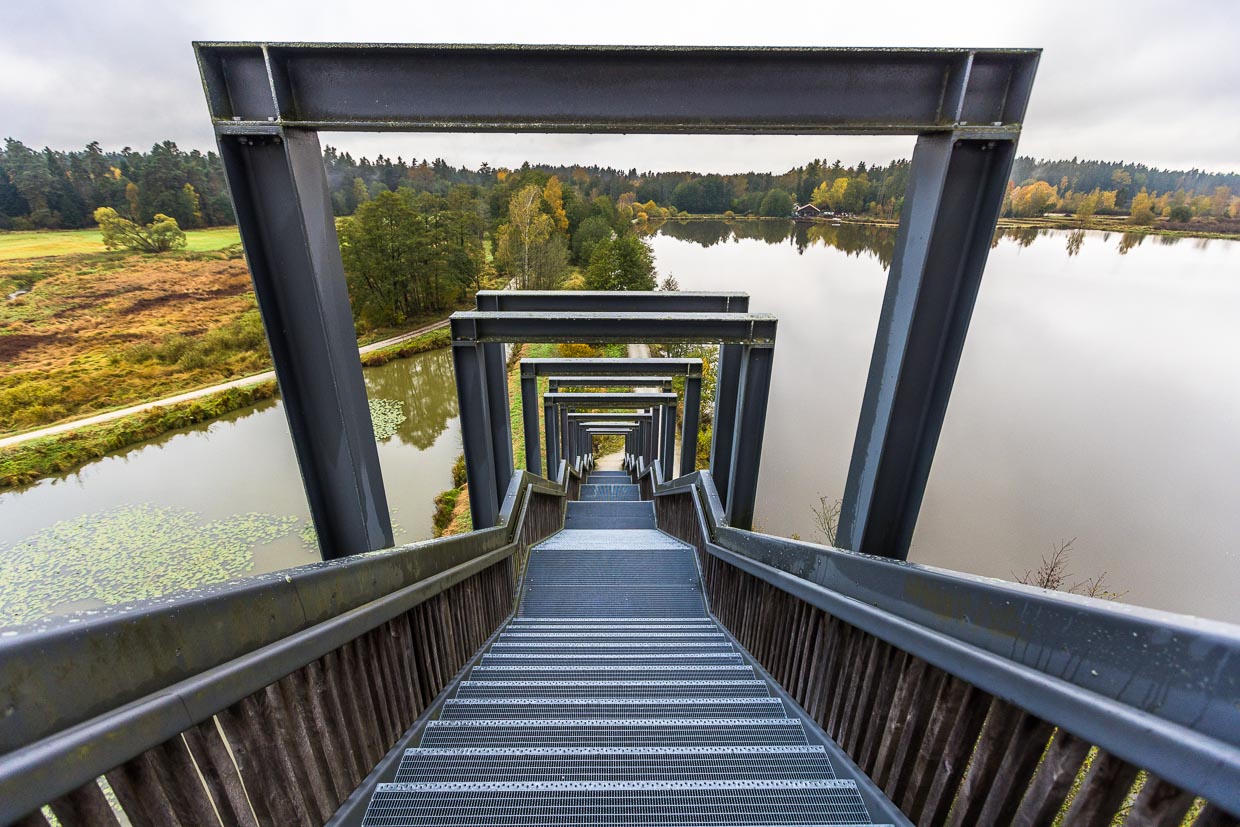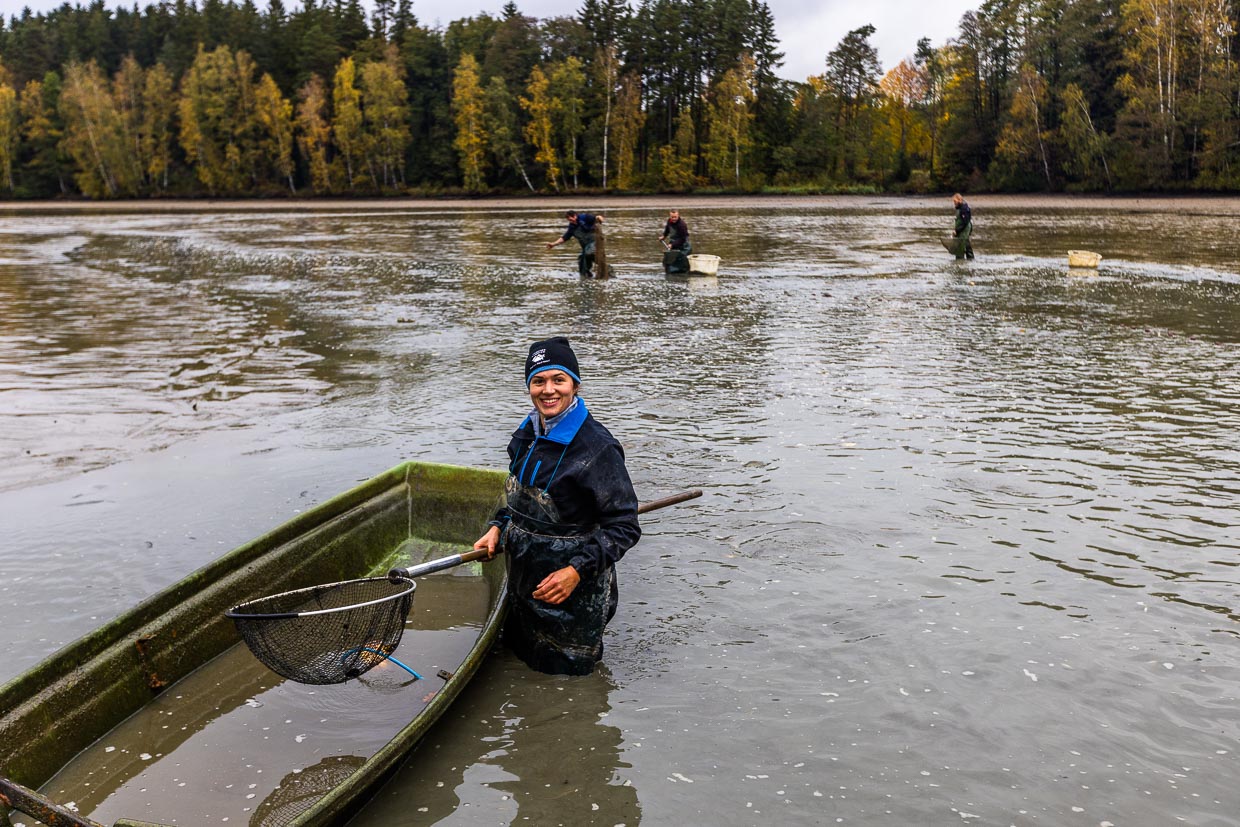Ponds have been farmed in the Upper Palatinate for over 1,000 years. Cistercian monks once farmed fish on a large scale, but today it is mainly the fishing families who pass on the centuries-old knowledge. Their fish farming is a key factor in nature conservation. Carp farming stands for tradition, experiencing nature and enjoyment. Everything can be combined on a trip to the district of Tirschenreuth. You can explore the Waldnaabaue nature reserve by bike or on hikes. Historical sites such as the Waldsassen Monastery and the Fischhof in Tirschenreuth tell the story of the Cistercian monks. Inns, restaurants and fish taverns offer a variety of carp dishes and pond owners guide visitors through their ponds.

Of sky ponds and monks
The Tirschenreuth pond pan lies in the middle of a landscape of meadows, forests and moors and is one of the oldest cultivated landscapes in Europe. The kaolin-rich soil in this region forms a natural pond liner. The fish-rich rivers Waldnaab and Wondreb meander through the landscape. These are ideal conditions for pond farming. Ponds that are filled by rainwater alone are called sky ponds here. The vertical outlet, a functional concrete structure, is called a monk. It is not known why this drain, which is located at the deepest point of the pond, bears this name. It is possibly a reminiscence of the monks who introduced professional pond farming to the region in the 12th century.

About pond pans and pond chains
The carp is a sustainable edible fish and a high-quality natural product. It swims for three summers in an intact ecosystem and feeds mainly on natural food in the pond. The carp season lasts from the beginning of October to the end of April. Pond keepers such as Thomas Beer from Mitterteich offer guided tours of their ponds. The master fisherman provides information about the course of the fishing year, from the spawning season in spring, to the rearing of the young fish and fishing in the fall. Fishing begins at the end of September or beginning of October, depending on the weather. When the temperatures are still warm, moving the animals from the pond to the holding tanks is stressful. The cooler it gets, the more relaxed the carp will be at the bottom of the pond.


Fishing the ponds takes several weeks and the pond keepers are often dependent on the help of friends and family. Although fishing together looks like great fun, it is hard work. Timing is also important. The pond keeper drains the water from the pond via the outlet. If it is a chain of ponds, the fishing starts at the lowest pond so that the water from the higher ponds flows into the lower and already empty pond. This saves water. Nowadays, pond keepers can no longer be sure that their ponds are reliably filled with rainwater or a stream inlet. Emptying the ponds can take several days and must be checked regularly. The fish gather at the deepest point near the outlet. On the day of fishing, transport basins, nets, cachers and tractors are brought into position and the helpers slip into their waterproof waders.



The carp paradox
Pond farming takes place in harmony with nature and makes a valuable contribution to biodiversity. An intact ecosystem such as the Tirschenreuth pond basin with meadows, forests, moors and man-made ponds has also led to the colonization and reproduction of animals, which in turn now threaten the pond industry. The abundant food supply in the carp ponds has led to a sharp increase in the population of otters, cormorants and herons. At the same time, all three enjoy strict protection status. Hunting them is prohibited all year round. The beaver also feels at home in the Upper Palatinate. Although they are vegetarians, they like to dig holes in dams and obstruct intake pipes and drains with their relentless urge to create. Pond keepers have to check the pond facilities very often. If a construction-mad beaver causes the uncontrolled draining of a pond, this means a total loss for the pond manager. Otters, cormorants and herons eat fish. An otter can eat up to 1.2 kilos of fish per day.

A pond manager who has put the carp larvae into the pond three years earlier never knows on the day of fishing how many of his fish have made it to the third summer. Due to extensive management and the increase in natural predators, the fish population is declining. This leads to ever-increasing financial losses for pond keepers. As a result, they are increasingly going out of business. Pond areas are being drained and used for other purposes. There are only losers in this development. When the cultural landscape of pond farming disappears, the habitat of many protected plants and animals also disappears.

Monks with business acumen
Yet fish farming was once a very profitable business. In a region where it was always somewhat colder than elsewhere and the soil did not produce the desired agricultural yield, Cistercian monks began organized fish farming in the 12th century. They saw carp as an ideal fasting food and also a source of income. The monks were forbidden to eat four-legged animals on 150 fasting days a year. Fish, on the other hand, was considered a river vegetable and was less susceptible to crop failure or disease. It could also be sold at a high price. At the time, one kilo of carp was worth six kilos of beef or 24 liters of beer. In the 13th and 14th centuries, the Cistercian monastery of Waldsassen dominated pond farming on the Waldnaab and Wondreb rivers. It was popularly said at the time that the Waldsassen monastery had so many ponds that the monks could fish a different one every day of the year.

Paving the way for the economic success was a building that still stands out today. Abbot Hermann, the fourth abbot of Waldsassen Monastery, founded in 1133, had an artificial canal built. For three summers from 1216 to 1219, up to 100 front-line builders fought their way through granite and gneiss every day with nothing more than a hammer and chisel. In these three years, they broke out 500 cubic meters of stone over a length of 80 meters. The result was an artificial drain for the lower town pond in 1219. This masterpiece of medieval pond construction is now somewhat hidden under a bridge on the outskirts of Tirschenreuth. The 800-year-old drainage system is considered to be the oldest monument of the Waldsassen monastery, which was the capital of the imperial and therefore very important Cistercian abbey for centuries.


On dry land
In 1570, the monastery had around 160 ponds for carp farming and 14 streams in which trout were bred. The monks had the ponds built on their own land as well as on land owned by others. Pond pans such as the one near Tirschenreuth or large individual ponds such as the Kornthaler Weiher were created. The secular administrative center for the Cistercians’ large-scale fish farming was the Tirschenreuth fish farm. A fish master coordinated the fish trade there. With the secularization in 1803 and the dissolution of the Waldsassen monastery, pond farming also became detached from religion in a certain sense. From then on, carp farming was in the hands of families. The large town ponds near Tirschenreuth were drained and the imposing Fischhofbrücke bridge stood on dry land for 200 years. Since 2012, a town pond has once again flowed around the baroque bridge and visitors can learn a lot about the tradition of carp farming in the town’s museum quarter. Waldsassen Monastery and the famous monastery library stand for the outstanding role of the Cistercian monks and the traces they left behind in the region. Waldsassen Abbey is also part of the transnational cooperation project Cisterscapes, which links 17 former Cistercian monastic sites in five countries via a long-distance hiking trail.

Culinary carp
The carp season runs from the beginning of October to the end of April and carp can be found on almost every menu in the Tirschenreuth region during this time. Fresh, regional and sustainable are three good reasons to turn to the culinary delights of carp. Carp from traditional pond farming is a real delicacy and can be prepared in a variety of ways. Click here for the report The carp – an underestimated fish.
Travel tips Upper Palatinate Forest and Tirschenreuth pond pan
Upper Palatinate Forest. Tips for leisure activities and cycling and hiking tours
Fischhof Beer offers rooms and apartments as well as guided tours of the ponds
Fischhof Bächer Restaurant and fish store as well as fish farm
Waldsassen Monastery and transnational project Cisterscapes – In the footsteps of the Cistercians
The research was supported by the Upper Palatinate Forest Tourism Association

